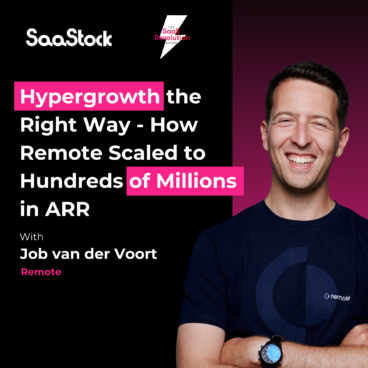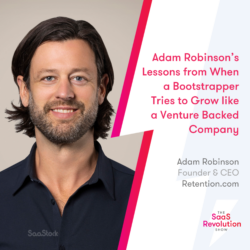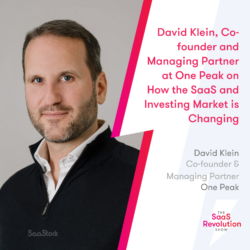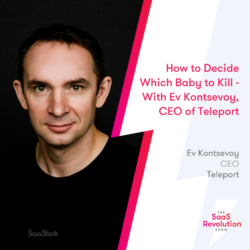In this episode of the SaaS Revolution Show our host Alex Theuma is joined by Job van der Voort, Co-Founder & CEO at Remote, who shares their hypergrowth journey and how they scaled Remote to hundreds of millions in ARR.
“I would always say this is a great problem to have. If you grow really, really fast and it’s a luxury problem, and if you just embrace it like that, then everything becomes much easier. Just embrace it in the most honest possible way, which is that, wow, we get so much interest that we have to solve these really difficult problems right now. It’s for the sake of, you know, our success, or at least the direction of success. To me, that was never difficult. What is difficult is how it affects the rest of your life.”
In the episode, Job shares:
- The operational and human problems Remote faced during rapid growth.
- His attitude towards increased responsibility and fighting fires – ‘it’s a great luxury to have problems to solve’.
- Why too many people get distracted by ‘building for the sake of building’ and deprioritise talking to customers and actively marketing the product.
- How to stay clear-headed during a period of hypergrowth.
- ‘The sun will shine tomorrow’, how he stays motivated when times get tough.
Watch or listen to the episode below or read on for key takeaways.
Listen to the audio now:
One of the exciting things about SaaS is that every now and then, a company emerges that defies expectations. An outlier with exponential growth that, regardless of what else is going on in the market, reminds us that anything is possible. The stars need to align–the right leaders, the right timing, and a good dose of luck but it can happen.
Remote is a global HR platform that enables companies to find, hire, manage, and pay people across the world. Remote is also one of those outliers and a synonym for SaaS hyperscaling.
From launching in January 2019 to reaching $600 million ARR in 2023, in this episode, Co-founder and CEO Job vander Voort shares the secrets to Remote’s success.
Remote’s hyperscaling in a nutshell
A neuroscientist by training, Job joined Gitlab in 2015 and ran Product for five years. During this time, Gitlab built a fully distributed company, hiring people from all over the world and growing from a team of 5 to 450+, but they constantly faced one big problem: paying remote staff. Job decided he was going to solve the problem himself and joined forces with his friend, an engineer and two-time CTO, Marcelo Lebre, to set up Remote in January 2019.
Big believers in remote work, they went out of their way to buy the ‘remote.com’ domain name (paid in partial equity now worth millions) and started building a “really complex” product. When the Covid-19 pandemic hit in March 2020, they still didn’t have a product. But after onboarding their first customer a few months later, hyperscaling kicked in.
While they admit that their “main marketing channel was pure luck and timing,” there’s nothing lucky about the staggering results that followed:
- ARR: $0-1 million in six months.
- ARR: $1 million to hundreds of millions in three years.
- Headcount: 15 people (June 2020), 40 people (January 2021), ~600 people (December 2021), ~2000 people (October 2024).
During this hypergrowth, Remote made lots of small mistakes, but also some excellent decisions. Here are my top five.
1. Build a product you’re excited to use
When building the product, Remote didn’t cut corners or rely on third parties. Instead they took the time to craft a product that achieved their end-goal (“a place where companies could hire the best people and people could work for the company best suited to what they like”) and offered an excellent experience.
They didn’t want to build a product that simply solved one pain point, but a product that uprooted the status quo of multiple global HR elements (including payroll, managing contractors, managing HR information etc) and something that they – as a growing remote company – were excited to use on a daily basis. As a result, they quickly understood the product’s flaws and were motivated to rectify them.
2. Speak to prospects early on
Even before Day One, Job was meeting with prospects daily to learn what kind of product to build. It took 1.5 years to create the product, but Job used that time to reach out directly to prospects, ask for feedback and actively market the product, so that when they launched, they were already primed for hyperscaling and didn’t need to worry about finding customers.
For Job, there’s no magic to customer outreach, it’s simply about using LinkedIn and getting the ball rolling. “It’s kind of a grind because you have to do much more than you think you need to, but it’s a good grind because you learn a lot.”
3. Deliberately instil a remote culture
With the company doubling in size every few months, Remote wrote a handbook as a foundation for new joiners and then focused on hiring really ambitious people. The handbook formed part of Remote’s deliberate attempt to create a remote-first culture. Conscious that company culture would struggle to arise organically without an office, Remote outlined an underlying message and way of doing things, so there was unity no matter where employees came from or worked.
In particular, Remote created a culture where all employees could enjoy their work, be themselves, do their best job, and have fun. As the company scaled, all new joiners were able to expand upon that culture so it never stagnated, but grew alongside the company – an ongoing process that is still shaping their culture today.
4. Understand which areas to grow and at what pace
Despite raising hundreds of millions in VC capital, Remote has valued efficiency throughout hyperscaling. As such, instead of scaling every company function post fundraise – which leads to growing elements you don’t need – they looked across each different department, analysed what was working and then allocated funding to the areas that needed growth.
They also decided at what speed each department should scale, so they didn’t grow teams unnecessarily quickly and run out of money. As a result, every department was contributing to the growth mission in a different way at different times.
5. Prepare mentally
“What is difficult is how it affects the rest of your life.” For Job, the toughest challenge of hyperscaling was the mental side. He enjoyed the increased responsibility and constant firefighting (“it’s a great luxury to have problems to solve”), but found the longer hours, lack of family contact, and loneliness of the CEO role challenging.
He believes the best way to combat the mental challenge of hypergrowth is to stay clear-headed (“sleep well, eat well, work out”) and remember, as Dory espouses in Finding Nemo, to “keep swimming” as no matter how tough it gets, “the sun will shine tomorrow”.





